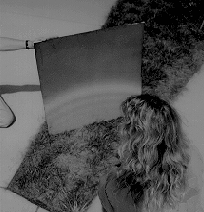

PURPOSE: To observe an almost complete circular rainbow formed by glass beads.
DESCRIPTION: Glass beads are glued to a black screen to simulate water drops. When the card is viewed from close up, with the light source (or sun) coming from behind the observer, the primary rainbow can be seen at an angle of about 22 degrees. The secondary rainbow is at an angle of about 88.5 degrees, and must be viewed by looking nearly parallel to the surface of the card, so it cannot be seen while viewing the first order rainbow. This is best observed on an individual basis.
Several features of this rainbow are similar to features of real rainbows: the colors are in the correct order and are realistic, the area outside the rainbow is very dark, compared to the area inside the rainbow, and several supernumerary bows can easily be seen.
The real primary rainbow is at about 41 degrees, and the secondary rainbow is at about 52 degrees. The higher index of refraction of the glass beads shifts the primary rainbow to 22 degrees and the secondary rainbow to 88.5 degrees.
SUGGESTIONS:
REFERENCES: (PIRA 6A46.16) See Demonstration Reference File for several interesting papers covering aspects of the rainbow and this demonstration.
EQUIPMENT: Black screen with 0.007" diameter glass beads, bright point source or sunlight.
SETUP TIME: None.
 |  |  |  | 
|